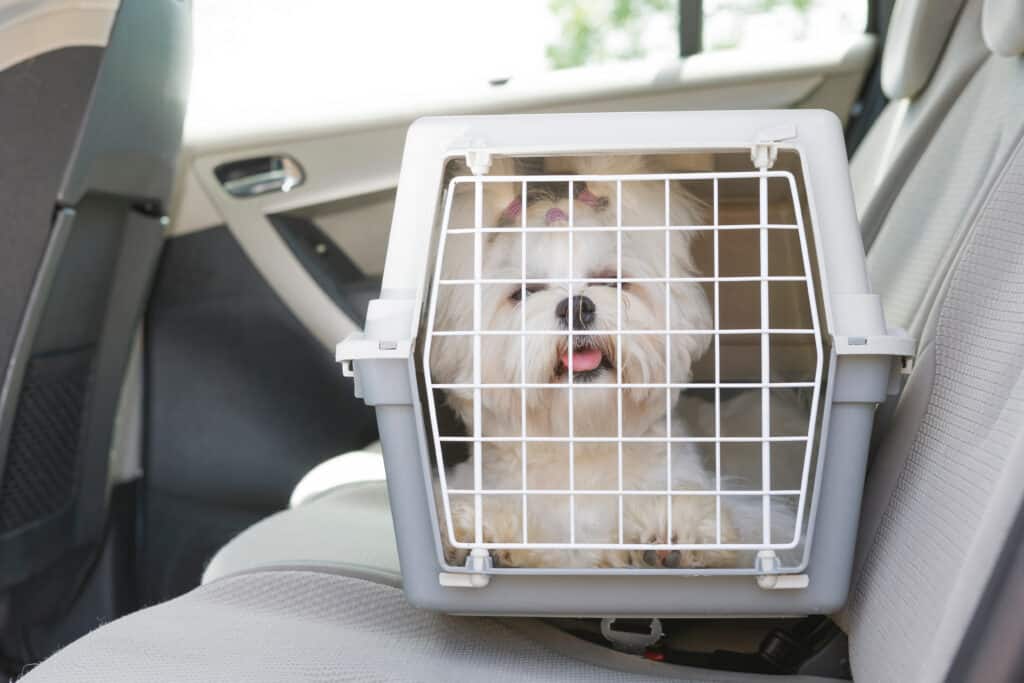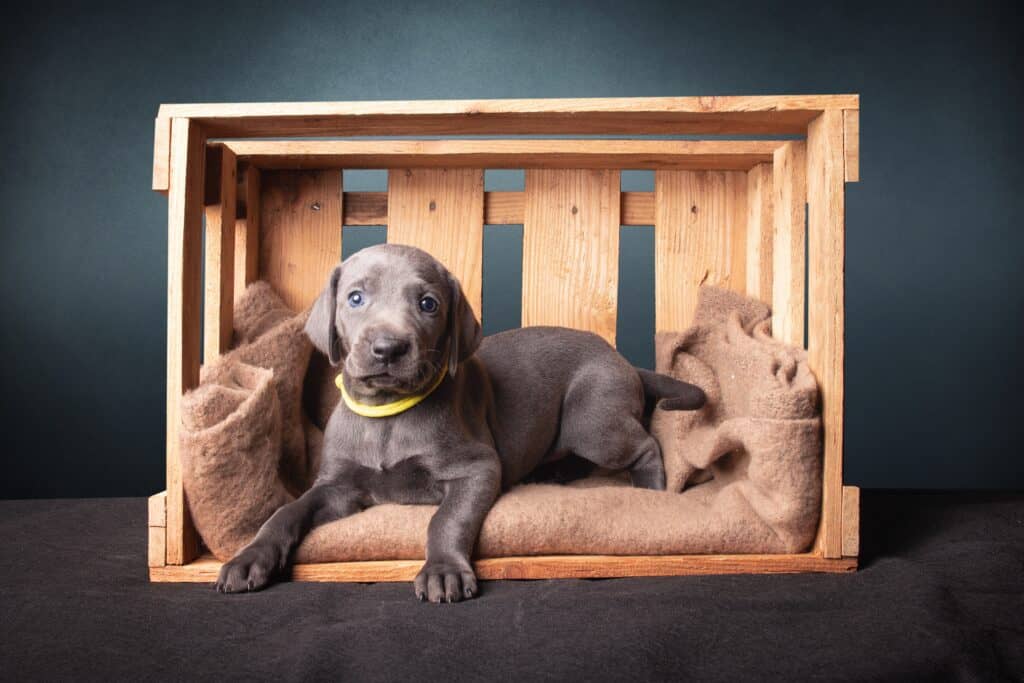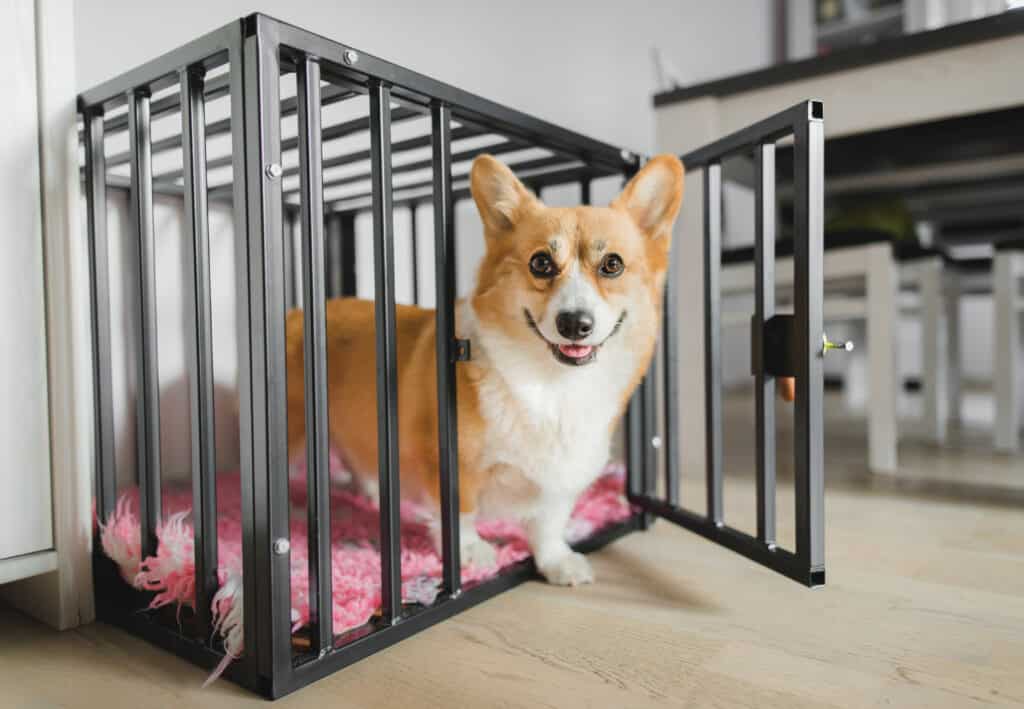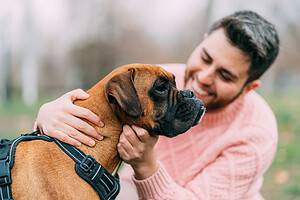There’s no doubt that dog crates make potty training much more manageable – after all, it’s a lot harder to keep an eye on your pet when they have the entire house to wander around, especially if you have a sneaky dog. But did you know that crates can also be a great way to keep your furry friend safe when you’re not at home?
Picking the right crate makes all the difference in your and your pup’s daily routine. It can help with traveling or when you need to eat a sandwich without your doggie making big eyes at you. So, how do you find the perfect crate for your pet? It’s not always easy.
With a bit of research and some measuring tape, you should be able to find the right size dog crate for your furry friend. And when you do, make sure to celebrate by giving your pup a special treat. You will soon be able to measure your dog and decide which type of crate works for your and your dog’s needs. Let’s start breaking down all the steps and tips you need to know!

Dog crates can be useful for keeping your pup safe while traveling together.
©Monika Wisniewska/Shutterstock.com
What to Consider When Choosing a Dog Crate
When choosing the perfect dog crate, there are several things to consider. You’ll want to start with the type of crate you need. If you love traveling a lot with your dog, a soft-sided crate will be easier to move and more comfortable for your dog.
The soft-sided crates don’t last as long if your dog likes to scratch and chew, so you may want to try the plastic versions. The plastic crates are more durable than the soft-sided ones but not as easy to clean as the wire ones. If easy cleaning is your goal, the wire one would be best. Here is what each style of dog crate is like:
Furniture Dog Crates: Often made from wood, these dog crates blend into your home for a modern look. Larger dog breeds may be unable to find one that suits their size.
Wire Style: There usually are only two options for this style as far as colors go: black or silver. It has a pan under that slides out for easy cleaning. It would help if you used a dog bed or blanket to keep your dog comfortable.
Plastic Carriers: Creates a darker space for the dog, which is great for bedtime. It is portable and easy to clean because there is no fabric inside it. It’s hard to find for larger dogs and is less durable than other options.
Soft-sided: This is the lightest option of them all. It is also the one with the least durability. Anxious or bored dogs can easily tear this apart, so it’s not suited well for them. Since it has fabric, it can get stains and retain odors if not cleaned regularly.

A furniture-style dog crate may be a good option if you’re looking for something to blend in with the rest of your home.
©Wirestock Creators/Shutterstock.com
The Right Size Crate for Your Dog
Dog crates come in all different shapes and sizes. And while it may be tempting to choose an enormous crate for your dog, it’s essential to select a size that’s appropriate for their needs.
If a dog crate is too big, dogs will often use one side of the crate as a bathroom, creating health problems. In addition, some dogs may feel overwhelmed in a large crate and become anxious or stressed.
On the other hand, dogs may not have enough room to move around comfortably if a dog crate is too small. They may also develop behavioral problems due to the lack of space. For these reasons, selecting the proper size dog crate for your pet is essential.
The first step is to measure your dog correctly. You can measure from their nose to where their tail starts, then add 2-4 inches. The dog needs only enough room to turn around in the cage. Measure their shoulder height when they are standing and add six inches. That is the height you’ll need for the cage. Here is a helpful chart!
| Crate Size | Dog Length | Weight | Breed Examples |
|---|---|---|---|
| Extra small | 18″ – 22″ | Up to 25 lbs | Chihuahua |
| Small | 24″ | Up to 25 lbs | Jack Russel Terrier |
| Medium | 30″ | 26 – 40 lbs | Cocker Spaniel |
| Intermediate | 36″ | 41 – 70 lbs | Bulldog |
| Large | 42″ | 71 – 90 lbs | Australian Shepherd |
| X-Large | 48″ | 91 – 110 lbs | Bloodhound |
| XX-Large | 54″ | 110 lbs | Irish Wolfhound |
Crate Training Tips and Tricks
One thing you must do for your dog is to crate train them. A crate provides a safe space for your dog to retreat to when they need a break from being overstimulated or when they get too rowdy. It also gives you a place to safely put your dog when you can’t keep an eye on them, such as when you’re cooking or running errands. Crate training can take some time and effort, but it’s well worth it in the end. Here are some dog-approved ideas to help you and your dog get started:
- Start by leaving the cage open and allowing your dog to explore the crate gradually. Let them warm up to it on their own terms without putting them in it.
- Once they’re comfortable with the crate, start feeding them treats in it. This will help create a positive connection with the crate.
- When you do put your dog in the crate, make sure to do so calmly and confidently. Give them a treat as soon as they’re in the crate, so they know they’re being rewarded for going there.
- Lastly, ensure your dog has plenty of opportunities to get out of the crate throughout the day. Let them out for bathroom breaks, and provide them with plenty of time to play and stretch their legs!

Be sure to give your dog plenty of opportunities to leave the crate.
©Jus_Ol/Shutterstock.com
How to Make a Dog Crate Comfortable for Your Pup
Dog crates can be an excellent way to keep your pet safe and out of trouble when you cannot watch your dog. But how can you make the dog crate as comfortable as possible? Making a dog crate comfortable for your pet is vital for their well-being and that they see it as a positive space. You can add a few things to ensure your dog is comfortable in their crate.
Add bedding and make sure it is comfortable and washable. You can do this by getting a dog bed or pillow. For larger dogs, cave dog beds work well in their large crates. Folded blankets are also another good option. This will let your dog have a soft place to rest their head and provide padding from the hard floor of the crate.
You can also add a toy or chew bone to keep your dog entertained and distracted from its surroundings. It can also be an opportunity to give your dog a dental chew to get chewing off their mind and enjoy clean teeth. If it’s time for a nap, place the crate in a quiet room in the house where your dog can feel calm and relaxed. You can give them calming treats to help them sleep.
Conclusion
It shouldn’t be hard to pick the right crate for your pet. With this guide, it should be a breeze. Crates can be used for potty training and to keep dogs safe when not at home. When choosing a perfect size dog crate, there are several things to consider. Choosing a dog crate that is appropriate for your dog is essential, as too large of a crate can create a messy potty situation.
Selecting the proper size dog crate is necessary because a dog may not have enough room to move around comfortably if it is too small, and they may develop behavioral problems due to the lack of space. There are different types of dog crates, each with its benefits and drawbacks.
You can find the right-sized dog crate for your pet by doing some research and measuring tape. Remember to train your dog to use a crate. Start by gradually introducing them to it and feeding them treats inside. Once they’re comfortable, put them in the crate calmly and confidently with a treat, then let them out often. Happy dog crate shopping!
The photo featured at the top of this post is © Jus_Ol/Shutterstock.com
Ready to discover the top 10 cutest dog breeds in the entire world?
How about the fastest dogs, the largest dogs and those that are -- quite frankly -- just the kindest dogs on the planet? Each day, AZ Animals sends out lists just like this to our thousands of email subscribers. And the best part? It's FREE. Join today by entering your email below.
Sources
- Pet Crates Connect , Available here: https://www.petcratesdirect.com/pages/dog-crate-sizes
- Petco, Available here: https://www.petco.com/content/petco/PetcoStore/en_US/pet-services/resource-center/pet-guides/dog-crates-guide.html#:~:text=We%20recommend%20measuring%20the%20length,Avoid%20too%20much%20space.
FAQs (Frequently Asked Questions)
How big should a puppy crate be?
Research what the estimated size of your puppy will be after it’s full grown, and get a crate that fits the recommendations for that size. You can use a divider in wire-style cages until they grow into it. You can also replace the crates as they grow, but that’s not as efficient.
Can dogs stay in a crate all day?
No, because it can cause your dog to become depressed and anxious. They won’t have access to use the bathroom and will soil themselves. Dogs need exercise that will be missed by being in a cage and other basic needs. Please don’t leave them in a crate too long.
Thank you for reading! Have some feedback for us? Contact the AZ Animals editorial team.







